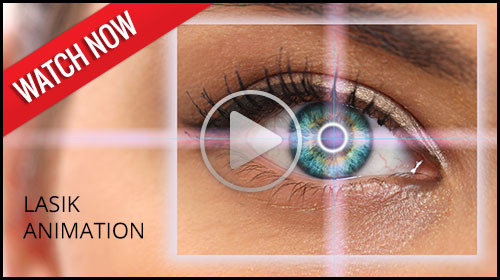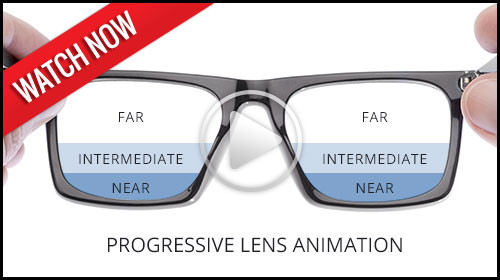Our Services

As a fully licensed and equipped optometric practice, EyeCare Plus offers a complete range of eye care services to all our patients.
Whether the eye care issue involves correcting refractive errors with eyeglass or contact lenses, helping a student find amazing frames, or diagnosing/treating eye conditions and diseases, our experienced team will identify and implement the best eye care solutions for you.
Eye Health Evaluation
With our years of experience in diagnosing and treating typical vision disorders such as nearsightedness, farsightedness, amblyopia, presbyopia, cataracts, macular degeneration, and diabetic retinopathy, James Crockett and George Eischens and their team are equipped to provide appropriate therapeutic medical eye care.
At the same time, the EyeCare Plus team offers a wide array of high-quality eye care products at reasonable prices. Our patients never pay too much for the best quality in eyeglasses, contact lenses, sunglasses, progressive and bifocal lenses, and outstanding service.
Treatment of Eye Disease
If you are diagnosed with an eye disease, you want the best treatment available to get your eyes healthy again. At EyeCare Plus, we stay current with best treatment practices. Based on your diagnosis, we may recommend a wide variety of approaches, including improved nutrition, prescription medicines, therapy and vision exercises, or medical procedures.
Good Eye Care Begins With A Yearly Eye Exam!
Although many do not realize it, the best way to protect your vision is with a yearly eye checkup. Even a basic eye exam can instantly detect many health-threatening conditions, such as tumors, vascular irregularities, and diabetes-related injury to the retina. At EyeCare Plus, that basic checkup is brief and painless.
InfantSEE
Make Sure Your Baby is Seeing the Most Important Things in His World.
"When should I schedule a comprehensive eye assessment for my baby?" The answer is simple, now. We recommend that all children have their first eye exam between the age of six through twelve months. Infant eye and vision assessments offer early detection of vision and eye health problems and are critical to a child’s development. Through the Optometry’s Charity™ - The AOA Foundation’s public health program, InfantSEE®, optometrists provide a one-time, comprehensive eye assessment to infants in their first year of life, typically between the ages of 6 and 12 months. These assessments are provided at no-cost to all families
It’s estimated that one in 10 children is at risk from an undiagnosed eye or vision problem that, if left untreated, can lead to difficulties later in school or even permanent vision loss. Additionally, many children at risk for eye and vision problems are not being identified at an early age, when many of those problems might be prevented or more easily corrected.
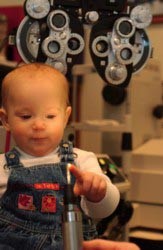 "Many eye conditions have no visual symptoms so detection by a parent or in a well-baby check-up may be difficult," said Dr. Glen Steele, optometrist and chair of the InfantSEE® committee. "Therefore, an early comprehensive vision assessment is the best way to ensure your baby has healthy eyes and appropriate vision development — now and in the future."
"Many eye conditions have no visual symptoms so detection by a parent or in a well-baby check-up may be difficult," said Dr. Glen Steele, optometrist and chair of the InfantSEE® committee. "Therefore, an early comprehensive vision assessment is the best way to ensure your baby has healthy eyes and appropriate vision development — now and in the future."
Since infants cannot speak, optometrists perform several non-invasive tests that evaluate visual acuity, refraction, motility, alignment, binocularity and overall eye health.The good news about a trip to the optometrist is that most babies seem to enjoy the ‘games’ we use to determine whether their visual development is progressing normally and their eyes are healthy
Technology
We have some of the most up to date technology in our office. Like our mission statement says, "to remain at the forefront of our profession by utilizing the latest technology and procedures". We acquire new equipment all the time. Here is some of the equipment that we have to date.
| Optomap | Topography |
| OCT | Visual Field |
| Digital Refraction | Diopsys |
Optomap
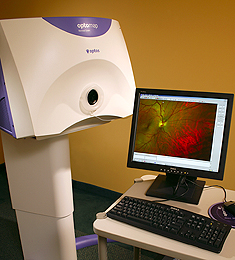 In our continued efforts to bring the most advanced technology available to our patients, Drs. Crockett, Lawrence and Eischens is proud to announce the inclusion of the Optomap Retinal Exam as an integral part of your eye exam.
In our continued efforts to bring the most advanced technology available to our patients, Drs. Crockett, Lawrence and Eischens is proud to announce the inclusion of the Optomap Retinal Exam as an integral part of your eye exam.
Many eye problems can develop without warning and progress with no symptoms. Early on, you might not notice any change in your vision. However, diseases such as macular degeneration, glaucoma, retinal tears or detachments, as well as other health problems such as diabetes and high blood pressure, can be detected with a thorough exam of the retina. The retina is the part of your eye that catches the image of what you are looking at, similar to the film in a camera.
An Optomap Retinal Exam provides:
- A scan to confirm a healthy eye or detect the presence of disease.
- An overview or map of the retina, giving your eye doctor a more detailed view than he can achieve by other means.
- The opportunity for you to view and discuss the Optomap images of your eye with your doctor at the time of your exam.
- A permanent record for your medical file, enabling your optometrist to make important comparisons if potential problems show themselves at a future examination.
Optical Coherence Tomography
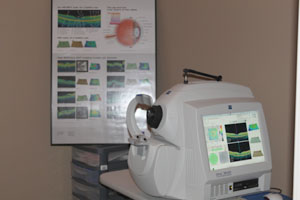
Optical Coherence Tomography, or OCT, is one of the best methods for viewing the microscopic structures in the back of the eye. This technology has been a part of modern eye care for approximately ten years. Now, at Eyecare Plus, we have incorporated one of the newest versions, the Zeiss Cirrus HD-OCT as part of our technical equipment. The Cirrus HD-OCT allows us to diagnose, treat, and manage such eye diseases as glaucoma, macular degeneration, and retinal detachments.
Corneal Topography
Corneal topography, also known as photokeratoscopy or videokeratography, is a non-invasive medical imaging technique for mapping the surface of the cornea, the outer structure of the eye. Since the cornea is normally responsible for some 70% of the eye's refractive power, its topography is of critical importance in determining the quality of vision.
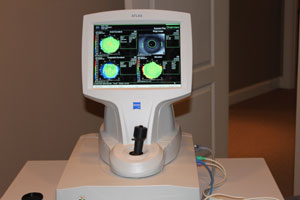 The three-dimensional map is therefore a valuable aid to the examining optometrist and can assist in the diagnosis and treatment of a number of conditions; in planning refractive surgery such as LASIK and evaluation of its results; or in assessing the fit of contact lenses. The topographer is just one more tool that can help you obtain valuable information in assessing refractive error. The procedure is carried out in seconds and is completely painless.
The three-dimensional map is therefore a valuable aid to the examining optometrist and can assist in the diagnosis and treatment of a number of conditions; in planning refractive surgery such as LASIK and evaluation of its results; or in assessing the fit of contact lenses. The topographer is just one more tool that can help you obtain valuable information in assessing refractive error. The procedure is carried out in seconds and is completely painless.
Visual Field
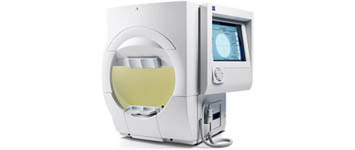 Visual Field Testing has been a staple in eye care for generations. Visual Field machines, such as our Humphrey Field Analyzer-II, test peripheral (or side) vision. Many ocular conditions “steal” peripheral vision without symptoms. The most well-known of these conditions is glaucoma. Other conditions, such as retinal detachments, brain tumors, or strokes cause very obvious peripheral vision loss. All of these conditions can be diagnosed and monitored with Visual Field testers.
Visual Field Testing has been a staple in eye care for generations. Visual Field machines, such as our Humphrey Field Analyzer-II, test peripheral (or side) vision. Many ocular conditions “steal” peripheral vision without symptoms. The most well-known of these conditions is glaucoma. Other conditions, such as retinal detachments, brain tumors, or strokes cause very obvious peripheral vision loss. All of these conditions can be diagnosed and monitored with Visual Field testers.
Digital refraction
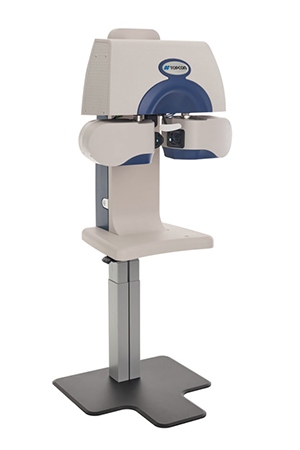 Chronos combines binocular autorefraction and keratometry measurements with binocular subjective testing and visual acuity in a single instrument that occupies a minimal amount of space and optimizes workflow. SightPilot guided refraction software simplifies refraction with a step-by-step guide that gives the operator instructions on how to proceed based on the patient’s response.
Chronos combines binocular autorefraction and keratometry measurements with binocular subjective testing and visual acuity in a single instrument that occupies a minimal amount of space and optimizes workflow. SightPilot guided refraction software simplifies refraction with a step-by-step guide that gives the operator instructions on how to proceed based on the patient’s response.
Diopsys Nova
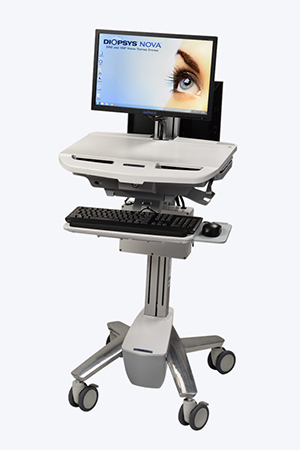 It’s not just our eyes that “see” so when evaluating visual function, it helps to get information on the entire visual pathway. Diopsys® VEP (visual evoked potential) and ERG (electroretinogram) vision testing gives you the ability to obtain objective information on the function of the whole vision system, from the anterior segment of the eye to the visual cortex.
It’s not just our eyes that “see” so when evaluating visual function, it helps to get information on the entire visual pathway. Diopsys® VEP (visual evoked potential) and ERG (electroretinogram) vision testing gives you the ability to obtain objective information on the function of the whole vision system, from the anterior segment of the eye to the visual cortex.
LASIK

LASIK, a form of refractive surgery, is an popular option for vision correction, often eliminating the need to wear glasses or contact lenses. Simply put, LASIK reshapes the cornea with a laser.
Other surgical alternatives have become available. Among these is a technique called phakic IOL implantation which involves implanting a lens behind the cornea, but in front of the iris. With this new option, many of those who were too highly nearsighted for LASIK are now candidates for refractive surgery.
If you are interested in refractive surgery, please let us know. Refractive surgery is not to be taken lightly. Detailed testing is necessary to determine whether or not you are a good candidate for the surgery. If testing shows you to be a good candidate, we can help you choose the refractive surgeon who is most appropriate for your case. In addition, we provide post-operative care for refractive surgery.

